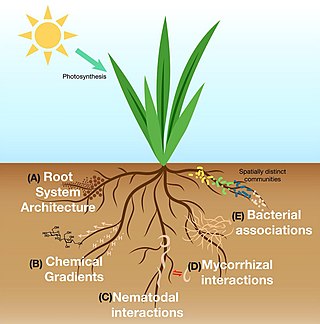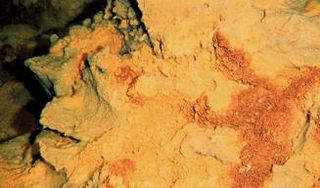Related Research Articles

The rhizosphere is the narrow region of soil or substrate that is directly influenced by root secretions and associated soil microorganisms known as the root microbiome. Soil pores in the rhizosphere can contain many bacteria and other microorganisms that feed on sloughed-off plant cells, termed rhizodeposition, and the proteins and sugars released by roots, termed root exudates. This symbiosis leads to more complex interactions, influencing plant growth and competition for resources. Much of the nutrient cycling and disease suppression by antibiotics required by plants occurs immediately adjacent to roots due to root exudates and metabolic products of symbiotic and pathogenic communities of microorganisms. The rhizosphere also provides space to produce allelochemicals to control neighbours and relatives.

In microbiology, the phyllosphere is the total above-ground surface of a plant when viewed as a habitat for microorganisms. The phyllosphere can be further subdivided into the caulosphere (stems), phylloplane (leaves), anthosphere (flowers), and carposphere (fruits). The below-ground microbial habitats are referred to as the rhizosphere and laimosphere. Most plants host diverse communities of microorganisms including bacteria, fungi, archaea, and protists. Some are beneficial to the plant, while others function as plant pathogens and may damage the host plant or even kill it.
A copiotroph is an organism found in environments rich in nutrients, particularly carbon. They are the opposite to oligotrophs, which survive in much lower carbon concentrations.

Thioploca is a genus of filamentous sulphur-oxidizing bacteria, in the order Thiotrichales. They inhabit both marine and freshwater environments, forming vast communities off the Pacific coast of South America and in other areas with a high organic matter sedimentation and bottom waters rich in nitrate and poor in oxygen. Their cells contain large vacuoles that occupy more than 80% of the cellular volume, used to store nitrate to oxidize sulphur for anaerobic respiration in the absence of oxygen, an important characteristic of the genus. With cell diameters ranging from 15-40 µm, they are some of the largest bacteria known. They provide an important link between the nitrogen and sulphur cycles, because they use both sulfur and nitrogen compounds. They secrete a sheath of mucus which they use as a tunnel to travel between sulphide-containing sediment and nitrate-containing sea water.
A microbial consortium or microbial community, is two or more bacterial or microbial groups living symbiotically. Consortiums can be endosymbiotic or ectosymbiotic, or occasionally may be both. The protist Mixotricha paradoxa, itself an endosymbiont of the Mastotermes darwiniensis termite, is always found as a consortium of at least one endosymbiotic coccus, multiple ectosymbiotic species of flagellate or ciliate bacteria, and at least one species of helical Treponema bacteria that forms the basis of Mixotricha protists' locomotion.
Rare biosphere refers to a large number of rare species of microbial life, i.e. bacteria, archaea and fungi, that can be found in very low concentrations in an environment.

The class Zetaproteobacteria is the sixth and most recently described class of the Pseudomonadota. Zetaproteobacteria can also refer to the group of organisms assigned to this class. The Zetaproteobacteria were originally represented by a single described species, Mariprofundus ferrooxydans, which is an iron-oxidizing neutrophilic chemolithoautotroph originally isolated from Kamaʻehuakanaloa Seamount in 1996 (post-eruption). Molecular cloning techniques focusing on the small subunit ribosomal RNA gene have also been used to identify a more diverse majority of the Zetaproteobacteria that have as yet been unculturable.
Acidobacterium capsulatum is a bacterium. It is an acidophilic chemoorganotrophic bacterium containing menaquinone. It is gram-negative, facultative anaerobic, mesophilic, non-spore-forming, capsulated, saccharolytic and rod-shaped. It is also motile by peritrichous flagella. Its type strain is JCM 7670.

The root microbiome is the dynamic community of microorganisms associated with plant roots. Because they are rich in a variety of carbon compounds, plant roots provide unique environments for a diverse assemblage of soil microorganisms, including bacteria, fungi, and archaea. The microbial communities inside the root and in the rhizosphere are distinct from each other, and from the microbial communities of bulk soil, although there is some overlap in species composition.
Microbiota-accessible carbohydrates (MACs) are carbohydrates that are resistant to digestion by a host's metabolism, and are made available for gut microbes, as prebiotics, to ferment or metabolize into beneficial compounds, such as short chain fatty acids. The term, ‘‘microbiota-accessible carbohydrate’’ contributes to a conceptual framework for investigating and discussing the amount of metabolic activity that a specific food or carbohydrate can contribute to a host's microbiota.

A microbiome is the community of microorganisms that can usually be found living together in any given habitat. It was defined more precisely in 1988 by Whipps et al. as "a characteristic microbial community occupying a reasonably well-defined habitat which has distinct physio-chemical properties. The term thus not only refers to the microorganisms involved but also encompasses their theatre of activity". In 2020, an international panel of experts published the outcome of their discussions on the definition of the microbiome. They proposed a definition of the microbiome based on a revival of the "compact, clear, and comprehensive description of the term" as originally provided by Whipps et al., but supplemented with two explanatory paragraphs. The first explanatory paragraph pronounces the dynamic character of the microbiome, and the second explanatory paragraph clearly separates the term microbiota from the term microbiome.

Trista Vick-Majors is an American Assistant Professor in Biological Sciences at Michigan Tech. She is an Antarctic biogeochemist and microbial ecologist, best known for her work showing that microorganisms are present under the Antarctic ice sheet.
In the field of microbiome research, a group of species is said to show a phylosymbiotic signal if the degree of similarity between the species' microbiomes recapitulates to a significant extent their evolutionary history. In other words, a phylosymbiotic signal among a group of species is evident if their microbiome similarity dendrogram could prove to have significant similarities with their host's phylogenic tree. For the analysis of the phylosymbiotic signal to be reliable, environmental differences that could shape the host microbiome should be either eliminated or accounted for. One plausible mechanistic explanation for such phenomena could be, for example, a result of host immune genes that rapidly evolve in a continuous arms race with members of its microbiome.
Kornelia Smalla is a chemist and biotechnologist at the Julius Kuehn Institute (JKI) in Braunschweig and a university lecturer in microbiology at the Technical University of Braunschweig.
Ellen Kandeler is a German biologist and agricultural scientist specialising in soil biology at University of Hohenheim. She also heads the Soil Biology area in the EU Biofector project.
Methylophaga thiooxydans is a methylotrophic bacterium that requires high salt concentrations for growth. It was originally isolated from a culture of the algae Emiliania huxleyi, where it grows by breaking down dimethylsulfoniopropionate from E. hexleyi into dimethylsulfide and acrylate. M. thiooxydans has been implicated as a dominant organism in phytoplankton blooms, where it consumes dimethylsulfide, methanol and methyl bromide released by dying phytoplankton. It was also identified as one of the dominant organisms present in the plume following the Deepwater Horizon oil spill, and was identified as a major player in the breakdown of methanol in coastal surface water in the English Channel.

Cable bacteria are filamentous bacteria that conduct electricity across distances over 1 cm in sediment and groundwater aquifers. Cable bacteria allow for long-distance electron transport, which connects electron donors to electron acceptors, connecting previously separated oxidation and reduction reactions. Cable bacteria couple the reduction of oxygen or nitrate at the sediment's surface to the oxidation of sulfide in the deeper, anoxic, sediment layers.
Kristen M. DeAngelis is a professor in the department of Microbiology at the University of Massachusetts where she studies soil microbes in relation to climate change.
Birgit Ann-Marie Margareta Nordbring-Hertz, was a Swedish scientist at Lund University known for her work on the interactions between fungi and nematodes.

The plant microbiome, also known as the phytomicrobiome, plays roles in plant health and productivity and has received significant attention in recent years. The microbiome has been defined as "a characteristic microbial community occupying a reasonably well-defined habitat which has distinct physio-chemical properties. The term thus not only refers to the microorganisms involved but also encompasses their theatre of activity".
References
- ↑ "Visitenkarte von Berg, Gabriele; Univ.-Prof. Dipl.-Biol. Dr.rer.nat. – TUGRAZonline – Technische Universität Graz". online.tugraz.at. Retrieved 27 December 2021.
- ↑ "Prof. Dr. Gabriele Berg – AcademiaNet". www.academia-net.org. Retrieved 27 December 2021.
- ↑ "Gabriele Berg on Austrian Center of Industrial Biotechnologie". Archived from the original on 3 December 2016. Retrieved 11 December 2016.
- ↑ "derStandard.at". www.derstandard.at. Retrieved 27 December 2021.
- ↑ Gabriele Berg publications indexed by Google Scholar
- ↑ Gabriele Berg on Medunigraz Archived 1 November 2016 at the Wayback Machine pdf